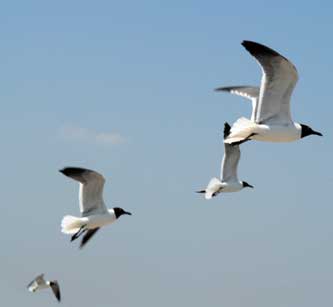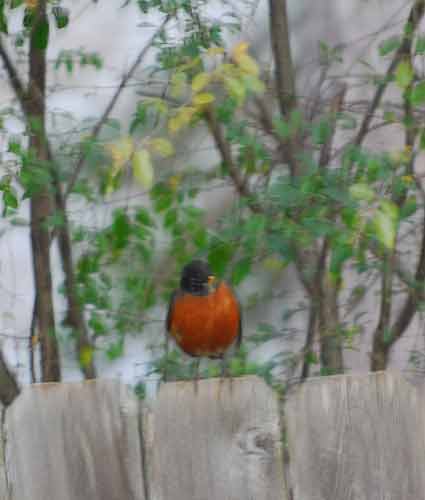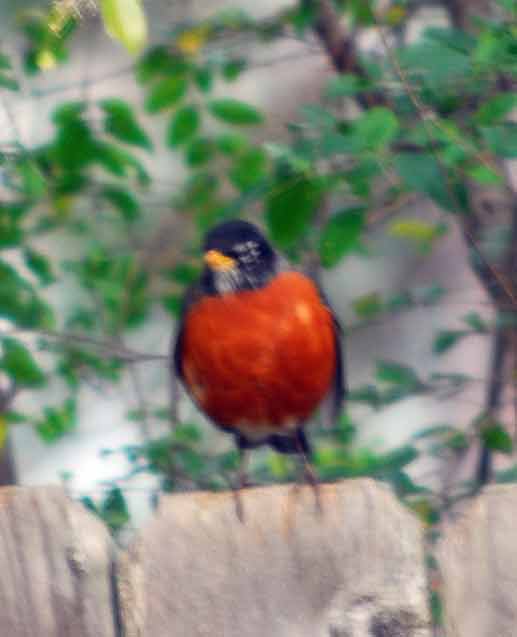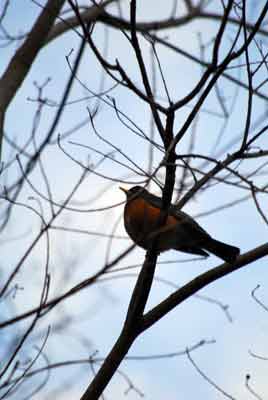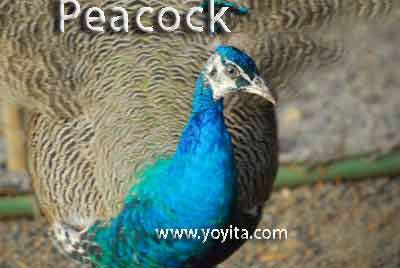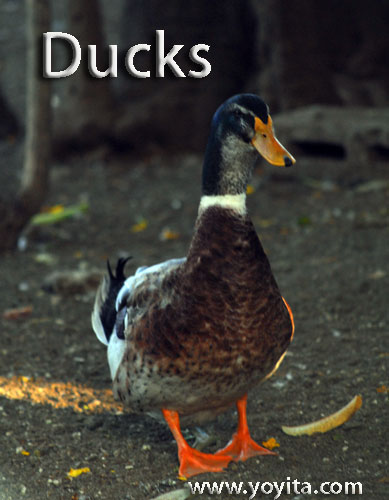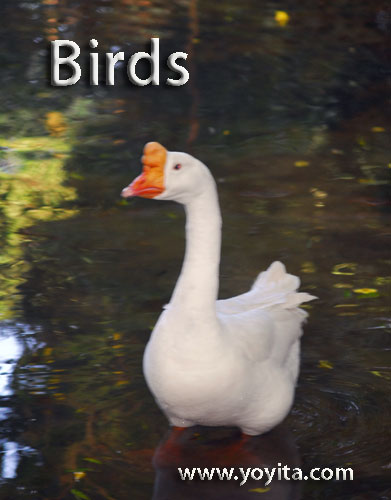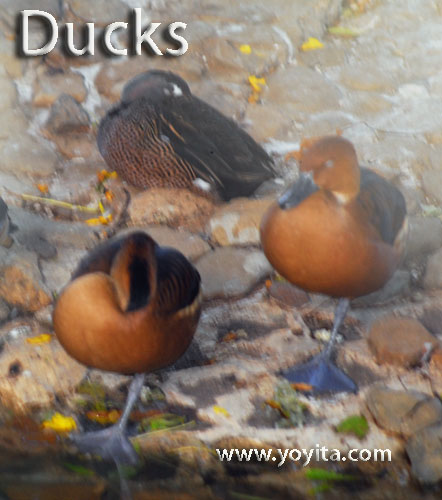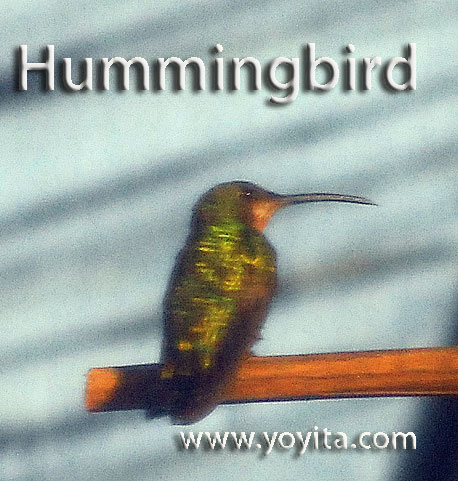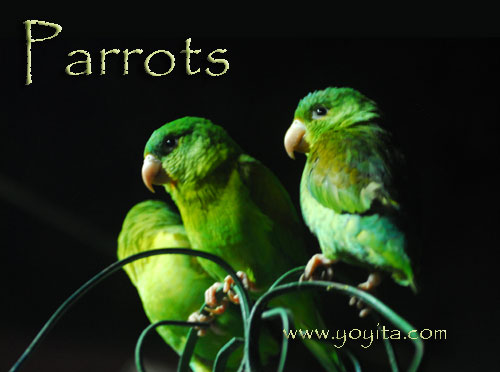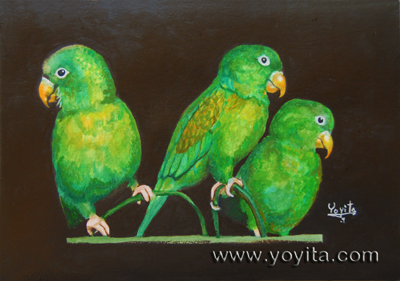Birds
Scientific classification of birds
Kingdom: Animalia
Phylum: Chordata
Subphylum: Vertebrata
(unranked) Archosauria
Class: Aves
Linnaeus, 1758
Birds are bipedal, warm-blooded, oviparous vertebrate animals characterized primarily by feathers, forelimbs modified as wings, and (in most) hollow bones. All birds reproduce sexually, although parthenogenetic eggs are known to be produced by the domesticated turkey on occasion and are suspected to occur in its wild ancestor.
Birds range in size from the tiny hummingbirds to the huge Ostrich and Emu. The ostrich has bigger eggs than any other bird. like the emu, it cannot fly. Depending on the taxonomic viewpoint, there are about 8,800�10,200 living bird species (and about 120�130 that have become extinct in the span of human history) in the world, making them the most diverse class of terrestrial vertebrates.
Birds feed on nectar, plants, seeds, insects, fish, mammals, carrion, or other birds.
Most birds are diurnal, or active during the day, but some birds, such as many species of owls and nightjars, are nocturnal or crepuscular (active during twilight hours), and many coastal waders feed when the tides are appropriate, by day or night.
Many birds migrate long distances to utilise optimum habitats, like the American Robin, while others spend almost all their time at sea (e.g. the Wandering Albatross). Some, such as Common Swifts, stay aloft for days at a time, even sleeping on the wing.
Common characteristics of birds include beak with no teeth, the laying of hard-shelled eggs, high metabolic rate, a four-chambered heart, and a light but strong skeleton. Most birds are characterised by flight, though the ratites are flightless, and several other species, particularly on islands, have also lost this ability. Flightless birds include the penguins, ostrich, kiwi, and the extinct Dodo. Flightless species are vulnerable to extinction when humans or the mammals they introduce arrive in their habitat. The Great Auk, flightless rails, and the moa of New Zealand, for example, all became extinct due to human influence.
Birds are among the most extensively studied of all animal groups. Hundreds of academic journals and thousands of scientists are devoted to bird research, while amateur enthusiasts (called birdwatchers, twitchers or, more commonly, birders) probably number in the millions.
Taxonomy
Birds are categorised as a biological class, Aves. The earliest known species of this class is Archaeopteryx lithographica, from the Late Jurassic period. Modern phylogenies place birds in the dinosaur clade Theropoda. According to the current consensus, Aves and a sister group, the order Crocodilia, together are the sole living members of an unranked "reptile" clade, the Archosauria.
Birds are categorised as a biological class, Aves. The earliest known species of this class is Archaeopteryx lithographica, from the Late Jurassic period. Modern phylogenies place birds in the dinosaur clade Theropoda. According to the current consensus, Aves and a sister group, the order Crocodilia, together are the sole living members of an unranked "reptile" clade, the Archosauria.
Modern birds are divided into two superorders, the Paleognathae (mostly flightless birds like ostriches), and the wildly diverse Neognathae, containing all other birds.
Bird orders of Neornithes (modern birds)
This is a list of the taxonomic orders in the subclass Neornithes, or modern birds. The list of birds gives a more detailed summary of these, including families.
SUBCLASS NEORNITHES
Paleognathae:
* Struthioniformes, Ostrich, emus, kiwis, and allies
* Tinamiformes, tinamous
Neognathae:
* Anseriformes, waterfowl
* Galliformes, fowl
* Gaviiformes, loons
* Podicipediformes, grebes
* Procellariiformes, albatrosses, petrels, and allies
* Sphenisciformes, penguins
* Pelecaniformes, pelicans and allies
* Ciconiiformes, storks and allies
* Phoenicopteriformes, flamingos
* Falconiformes, falcons, eagles, hawks and allies
* Gruiformes, cranes and allies
* Charadriiformes, gulls, button-quail, plovers and allies
* Pteroclidiformes, sandgrouse
* Columbiformes, doves and pigeons
* Psittaciformes, parrots and allies
* Cuculiformes, cuckoos, turacos, hoatzin
* Strigiformes, owls
* Caprimulgiformes, nightjars and allies
* Apodiformes, swifts and hummingbirds
* Coraciiformes, kingfishers
* Piciformes, woodpeckers and allies
* Trogoniformes, trogons
* Coliiformes, mousebirds
* Passeriformes, passerines
Evolution
There is significant evidence that birds evolved from theropod dinosaurs, specifically, that birds are members of Maniraptora, a group of theropods which includes dromaeosaurs and oviraptorids, among others.[1] As more non-avian theropods that are closely related to birds are discovered, the formerly clear distinction between non-birds and birds becomes less so. Recent discoveries in northeast China (Liaoning Province), demonstrating that many small theropod dinosaurs had feathers, contribute to this ambiguity.
The basal bird Archaeopteryx, from the Jurassic, is well-known as one of the first "missing links" to be found in support of evolution in the late 19th century, though it is not considered a direct ancestor of modern birds. Confuciusornis is another early bird; it lived in the Early Cretaceous. Both may be predated by Protoavis texensis, though the fragmentary nature of this fossil leaves it open to considerable doubt if this was a bird ancestor. Other Mesozoic birds include the Enantiornithes, Yanornis, Ichthyornis, Gansus and the Hesperornithiformes, a group of flightless divers resembling grebes and loons.
The recently (2002) discovered dromaeosaur Cryptovolans was capable of powered flight, possessed a sternal keel and had ribs with uncinate processes. In fact, Cryptovolans makes a better "bird" than Archaeopteryx which is missing some of these modern bird features. Because of this, some paleontologists have suggested that dromaeosaurs are actually basal birds whose larger members are secondarily flightless, i.e. that dromaeosaurs evolved from birds and not the other way around. Evidence for this theory is currently inconclusive, but digs continue to unearth fossils (especially in China) of the strange feathered dromaeosaurs. At any rate, it is fairly certain that avian flight existed in the mid-Jurassic and was "tried out" in several lineages and variants by the mid-Cretaceous.
Although ornithischian (bird-hipped) dinosaurs share the same hip structure as birds, birds actually originated from the saurischian (lizard-hipped) dinosaurs (if the dinosaurian origin theory is correct), and thus arrived at their hip structure condition independently. In fact, the bird-like hip structure also developed a third time among a peculiar group of theropods, the Therizinosauridae.
An alternate theory to the dinosaurian origin of birds, espoused by a few scientists (most notably Lary Martin and Alan Feduccia), states that birds (including maniraptoran "dinosaurs") evolved from early archosaurs like Longisquama, a theory which is contested by most other scientists in paleontology, and by experts in feather development and evolution such as R.O. Prum. See the Longisquama article for more on this alternative.
Modern birds are classified in Neornithes, which are now known to have evolved into some basic lineages by the end of the Cretaceous (see Vegavis). The Neornithes are split into the Paleognathae and Neognathae. The paleognaths include the tinamous (found only in Central and South America) and the ratites. The ratites are large flightless birds, and include ostriches, cassowaries, kiwis and emus (though some scientists suspect that the ratites represent an artificial grouping of birds which have independently lost the ability to fly in a number of unrelated lineages). The basal divergence from the remaining Neognathes was that of the Galloanseri, the superorder containing the Anseriformes (ducks, geese and swans), and the Galliformes (the pheasants, grouse, and their allies).
The classification of birds is a contentious issue. Sibley & Ahlquist's Phylogeny and Classification of Birds (1990) is a landmark work on the classification of birds (although frequently debated and constantly revised). A preponderance of evidence seems to suggest that the modern bird orders constitute accurate taxa. However, scientists are not in agreement as to the relationships between the orders; evidence from modern bird anatomy, fossils and DNA have all been brought to bear on the problem but no strong consensus has emerged. More recently, new fossil and molecular evidence is providing an increasingly clear picture of the evolution of modern bird orders. See also: Sibley-Ahlquist taxonomy and dinosaur classification. |


